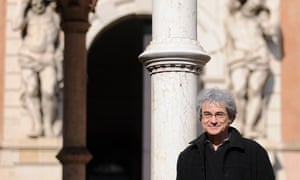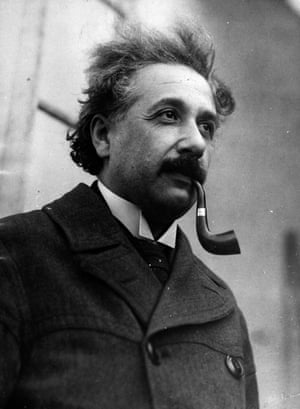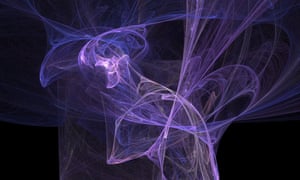What do we know about time? Language tells us that it “passes”, it moves like a great river, inexorably dragging us with it, and, in the end, washes us up on its shore while it continues, unstoppable. Time flows. It moves ever forwards. Or does it? Poets also tell us that time stumbles or creeps or slows or even, at times, seems to stop. They tell us that the past might be inescapable, immanent in objects or people or landscapes. When Juliet is waiting for Romeo, time passes sluggishly: she longs for Phaethon to take the reins of the Sun’s chariot, since he would whip up the horses and “bring in cloudy night immediately”. When we wake from a vivid dream we are dimly aware that the sense of time we have just experienced is illusory.
Carlo Rovelli is an Italian theoretical physicist who wants to make the uninitiated grasp the excitement of his field. His book Seven Brief Lessons on Physics, with its concise, sparkling essays on subjects such as black holes and quanta, has sold 1.3m copies worldwide. Now comes The Order of Time, a dizzying, poetic work in which I found myself abandoning everything I thought I knew about time – certainly the idea that it “flows”, and even that it exists at all, in any profound sense.
We meet outside the church of San Petronio in Bologna, where Rovelli studied. (“I like to say that, just like Copernicus, I was an undergraduate at Bologna and a graduate at Padua,” he jokes.) A cheery, compact fellow in his early 60s, Rovelli is in nostalgic mood. He lives in Marseille, where, since 2010, he has run the quantum gravity group at the Centre de physique théorique. Before that, he was in the US, at the University of Pittsburgh, for a decade.

Carlo Rovelli in Bologna. Photograph: Roberto Serra / Iguana Press / G/Iguana Press / Getty Images
He rarely visits Bologna, and he has been catching up with old friends. We wander towards the university area. Piazza Verdi is flocked with a lively crowd of students. There are flags and graffiti and banners, too – anti-fascist slogans, something in support of the Kurds, a sign enjoining passers-by not to forget Giulio Regeni, the Cambridge PhD student killed in Egypt in 2016.
“In my day it was barricades and police,” he says. He was a passionate student activist, back then. What did he and his pals want? “Small things! We wanted a world without boundaries, without state, without war, without religion, without family, without school, without private property.”
He was, he says now, too radical, and it was hard, trying to share possessions, trying to live without jealousy. And then there was the LSD. He took it a few times. And it turned out to be the seed of his interest in physics generally, and in the question of time specifically. “It was an extraordinarily strong experience that touched me also intellectually,” he remembers. “Among the strange phenomena was the sense of time stopping. Things were happening in my mind but the clock was not going ahead; the flow of time was not passing any more. It was a total subversion of the structure of reality. He had hallucinations of misshapen objects, of bright and dazzling colours – but also recalls thinking during the experience, actually asking himself what was going on.
“And I thought: ‘Well, it’s a chemical that is changing things in my brain. But how do I know that the usual perception is right, and this is wrong? If these two ways of perceiving are so different, what does it mean that one is the correct one?’” The way he talks about LSD is, in fact, quite similar to his description of reading Einstein as a student, on a sun-baked Calabrian beach, and looking up from his book imagining the world not as it appeared to him every day, but as the wild and undulating spacetime that the great physicist described. Reality, to quote the title of one of his books, is not what it seems.
He gave his conservative, Veronese parents a bit of a fright, he says. His father, now in his 90s, was surprised when young Carlo’s lecturers said he was actually doing all right, despite the long hair and radical politics and the occasional brush with the police. It was after the optimistic sense of student revolution in Italy came to an abrupt end with the kidnapping and murder of the former prime minister, Aldo Moro, in 1978 that Rovelli began to take physics seriously. But his route to his big academic career was circuitous and unconventional. “Nowadays everyone is worried because there is no work. When I was young, the problem was how to avoid work. I did not want to become part of the ‘productive system’,” he says.
Academia, then, seemed like a way of avoiding the world of a conventional job, and for some years he followed his curiosity without a sense of careerist ambition. He went to Trento in northern Italy to join a research group he was interested in, sleeping in his car for a few months (“I’d get a shower in the department to be decent”). He went to London, because he was interested in the work of Chris Isham, and then to the US, to be near physicists such as Abhay Ashtekar and Lee Smolin. “My first paper was horrendously late compared to what a young person would have to do now. And this was a privilege – I knew more things, there was more time.”

Albert Einstein worked at the Swiss patent office for seven years: ‘That worldly cloister where I hatched my most beautiful ideas.’ Photograph: Keystone/Getty Images
The popular books, too, have come relatively late, after his academic study of quantum gravity, published in 2004. If Seven Brief Lessons was a lucid primer, The Order of Timetakes things further; it deals with “what I really do in science, what I really think in depth, what is important for me”.
Rovelli’s work as a physicist, in crude terms, occupies the large space left by Einstein on the one hand, and the development of quantum theory on the other. If the theory of general relativity describes a world of curved spacetime where everything is continuous, quantum theory describes a world in which discrete quantities of energy interact. In Rovelli’s words, “quantum mechanics cannot deal with the curvature of spacetime, and general relativity cannot account for quanta”.
Both theories are successful; but their apparent incompatibility is an open problem, and one of the current tasks of theoretical physics is to attempt to construct a conceptual framework in which they both work. Rovelli’s field of loop theory, or loop quantum gravity, offers a possible answer to the problem, in which spacetime itself is understood to be granular, a fine structure woven from loops.
String theory offers another, different route towards solving the problem. When I ask him what he thinks about the possibility that his loop quantum gravity work may be wrong, he gently explains that being wrong isn’t the point; being part of the conversation is the point. And anyway, “If you ask who had the longest and most striking list of results it’s Einstein without any doubt. But if you ask who is the scientist who made most mistakes, it’s still Einstein.”
How does time fit in to his work? Time, Einstein long ago showed, is relative – time passes more slowly for an object moving faster than another object, for example. In this relative world, an absolute “now” is more or less meaningless. Time, then, is not some separate quality that impassively flows around us. Time is, in Rovelli’s words, “part of a complicated geometry woven together with the geometry of space”.
For Rovelli, there is more: according to his theorising, time itself disappears at the most fundamental level. His theories ask us to accept the notion that time is merely a function of our “blurred” human perception. We see the world only through a glass, darkly; we are watching Plato’s shadow-play in the cave. According to Rovelli, our undeniable experience of time is inextricably linked to the way heat behaves. In The Order of Time, he asks why can we know only the past, and not the future? The key, he suggests, is the one-directional flow of heat from warmer objects to colder ones. An ice cube dropped into a hot cup of coffee cools the coffee. But the process is not reversible: it is a one-way street, as demonstrated by the second law of thermodynamics.
Time is also, as we experience it, a one-way street. He explains it in relation to the concept of entropy – the measure of the disordering of things. Entropy was lower in the past. Entropy is higher in the future – there is more disorder, there are more possibilities. The pack of cards of the future is shuffled and uncertain, unlike the ordered and neatly arranged pack of cards of the past. But entropy, heat, past and future are qualities that belong not to the fundamental grammar of the world but to our superficial observation of it. “If I observe the microscopic state of things,” writes Rovelli, “then the difference between past and future vanishes … in the elementary grammar of things, there is no distinction between ‘cause’ and ‘effect’.”
To understand this properly, I can suggest only that you read Rovelli’s books, and pass swiftly over this approximation by someone who gave up school physics lessons joyfully at the first possible opportunity. However, it turns out that I am precisely Rovelli’s perfect reader, or one of them, and he looks quite delighted when I check my newly acquired understanding of the concept of entropy with him. (“You passed the exam,” he says.)
“I try to write at several levels,” he explains. “I think about the person who not only doesn’t know anything about physics but is also not interested. So I think I am talking to my grandmother, who was a housekeeper. I also think some young students of physics are reading it, and I also think some of my colleagues are reading it. So I try to talk at different levels, but I keep the person who knows nothing in my mind.”
His biggest fans are the blank slates, like me, and his colleagues at universities – he gets most criticism from people in the middle, “those who know a bit of physics”. He is also pretty down on school physics. (“Calculating the speed at which a ball drops – who cares? In another life, I’d like to write a school physics book,” he says.) And he thinks the division of the world into the “two cultures” of natural sciences and human sciences is “stupid. It’s like taking England and dividing the kids into groups, and you tell one group about music, and one group about literature, and the one who gets music is not allowed to read novels and the one who does literature is not allowed to listen to music.”
In the elementary grammar of things, there is no distinction between ‘cause’ and ‘effect’
The joy of his writing is its broad cultural compass. Historicism gives an initial hand-hold on the material. (He teaches a course on history of science, where he likes to bring science and humanities students together.) And then there’s the fact that alongside Einstein, Ludwig Boltzmann and Roger Penrose appear figures such as Proust, Dante, Beethoven, and, especially, Horace – each chapter begins with an epigraph from the Roman poet – as if to ground us in human sentiment and emotion before departing for the vertiginous world of black holes and spinfoam and clouds of probabilities.
“He has a side that is intimate, lyrical and extremely intense; and he is the great singer of the passing of time,” Rovelli says. “There’s a feeling of nostalgia – it’s not anguish, it’s not sorrow – it’s a feeling of ‘Let’s live life intensely’. A good friend of mine, Ernesto, who died quite young, gave me a little book of Horace, and I have carried it around with me all my life.”
Rovelli’s view is that there is no contradiction between a vision of the universe that makes human life seem small and irrelevant, and our everyday sorrows and joys. Or indeed between “cold science” and our inner, spiritual lives. “We are part of nature, and so joy and sorrow are aspects of nature itself – nature is much richer than just sets of atoms,” he tells me. There’s a moment in Seven Lessons when he compares physics and poetry: both try to describe the unseen. It might be added that physics, when departing from its native language of mathematical equations, relies strongly on metaphor and analogy. Rovelli has a gift for memorable comparisons. He tells us, for example, when explaining that the smooth “flow” of time is an illusion, that “The events of the world do not form an orderly queue like the English, they crowd around chaotically like the Italians.” The concept of time, he says, “has lost layers one after another, piece by piece”. We are left with “an empty windswept landscape almost devoid of all trace of temporality … a world stripped to its essence, glittering with an arid and troubling beauty”.
More than anything else I’ve ever read, Rovelli reminds me of Lucretius, the first-century BCE Roman author of the epic-length poem, On the Nature of Things. Perhaps not so odd, since Rovelli is a fan. Lucretius correctly hypothesised the existence of atoms, a theory that would remain unproven until Einstein demonstrated it in 1905, and even as late as the 1890s was being written off as absurd.
What Rovelli shares with Lucretius is not only a brilliance of language, but also a sense of humankind’s place in nature – at once a part of the fabric of the universe, and in a particular position to marvel at its great beauty. It’s a rationalist view: one that holds that by better understanding the universe, by discarding false beliefs and superstition, one might be able to enjoy a kind of serenity. Though Rovelli the man also acknowledges that the stuff of humanity is love, and fear, and desire, and passion: all made meaningful by our brief lives; our tiny span of allotted time.

No comments:
Post a Comment